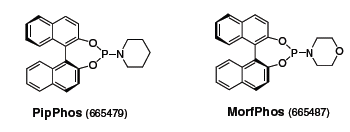DSM MonoPhos™ Ligands
Introduction
In collaboration with DSM, we are pleased to offer researchers a range of MonoPhos™ ligands.† Feringa and co-workers have invented a diverse array of these chiral, monodentate phosphoramidites based on the privileged BINOL platform.1 The MonoPhos™ ligands have exhibited high levels of enantiocontrol in synthetic transformations ranging from metalcatalyzed asymmetric 1,4-additions of organometallic reagents to allylic alkylations to desymmetrization of meso-cycloalkene oxides.2
Advantages of the MonoPhos™ Ligands
- Superior enantiocontrol in numerous transformations
- High activities at low catalyst loadings
- Hydrogenations under low-pressure conditions
- Applied in tandem reactions to yield valuable chiral organics
- First-to-market exclusivity for selected portfolio ligands
Representative Applications
The reactivity profile of these innovative chiral ligands is covered below and highlights the impressive breadth of valuable transformations mediated by the various portfolio products. In many documented cases, specific ligands have displayed unprecedented selectivities in reactions that form, for instance, chiral quaternary centers that cannot be readily generated via alternative methodologies.
Asymmetric 1,4-additions of Organometallic Reagents
Feringa and co-workers exploited the high activity of the (S,R,R)-phosphoramidite ligand shown in Scheme 1 in copper-catalyzed 1,4-additions of organozinc reagents to cyclohexenones.1 Interestingly, the in situ formed zinc species originating from the cyclohexenone is readily trapped via a palladium-catalyzed allylation. The Feringa group then completed a formal annulation process through a palladium-catalyzed Wacker oxidation, followed by an aldol cyclization. The high (96%) enantioselectivity of this methodology is completely retained throughout this synthetic strategy (Scheme 1).

Scheme 1.
High potential also exists for the use of organoaluminum reagents in asymmetric conjugate addition reactions, because of their commercial availability and proof of concept in carboalumination reactions. Woodward and co-workers have now pioneered the enantioselective phosphoramidite-catalyzed 1,4-additions of organoaluminum reagents to enones.3 This methodology provides facile access to chiral ketones with excellent enantioselectivities and in good yields (Scheme 2).
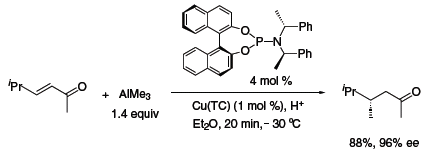
Scheme 2.
Highly Asymmetric Rhodium-Catalyzed Hydrogenation
Feringa has also gone to great lengths to develop structurally varied MonoPhos™ ligands in industrially useful transformations such as asymmetric hydrogenation.4 Impressively, the (S)-N-benzyl- N-methyl-MonoPhos™ derivative shown below has been utilized in highly selective hydrogenations of (E)-N-acylated dehydro-b-amino acid esters, affording the corresponding enantiopure b-amino acid derivatives (Scheme 3).4a The authors found that this ligand, after being screened versus related chiral phosphoramidites, afforded the highest enantiocontrol in hydrogenations albeit at slightly longer reaction times.
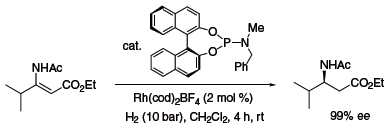
Scheme 3.
The Feringa research group has broadened the substrate scope of the asymmetric hydrogenation reaction by generating another chiral center on the amine moiety of the phosphoramidite ligand. Amazingly, this fine ligand tuning produces a very active and productive catalyst, which efficiently hydrogenates a wide range of acetamido derivatives in less time than the corresponding Me- DuPhos analogs.4a Note that the chiral (S,R)-phosphoramidite ligand below is the only ligand known to afford enantioselectivities for the substrate shown greater than 90% (Scheme 4).
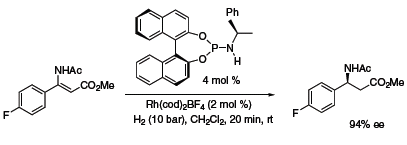
Scheme 4.
Recently, Feringa’s research group prepared additional structurally varied phosphoramidite ligands for rhodium-catalyzed asymmetric hydrogenations. The aptly named PipPhos and MorfPhos ligands (Scheme 5) contain piperidinyl and morpholinyl subunits, respectively, and are examples of easily synthesized chiral ligands for highly effective enantioselective transformations. Under mild reaction conditions including low H2 pressure, this catalyst system yields unprecedented enantioselectivities for several substrates such as dimethyl itaconate and a-dehydroamino ester derivatives (Scheme 6).5
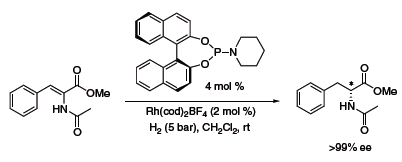
Scheme 6.
Asymmetric Regioselective Allylic Aminations
Hartwig and co-workers have succeeded in developing highly selective iridium catalysts with (R,R,R)-phosphoramidite L*.2g The allylic aminations of a wide variety of achiral allylic esters proceeded with total conversion and superb regioselectivity in many cases. The reaction shown clearly illustrates the power of this methodology, wherein cinnamyl acetate was converted to the allylic benzyl amine 3 in excellent yield and enantiopurity (Scheme 7). The authors mentioned that these valuable amination reactions were mediated by air-stable Ir complexes at ambient temperatures, which should lead to wide acceptance of this catalyst in bench-top organic synthesis.

Scheme 7.
As a complement to the Hartwig chemistry, Helmchen and co-workers have performed highly enantioselective iridiumcatalyzed intra- and intermolecular aminations with N-nucleophiles.6a Impressively, dicarbonate 5 reacts smoothly under the reaction conditions to afford the pyrrolidine products 6a and 6b in moderate yield but with excellent selectivity (Scheme 8).
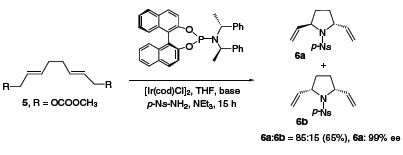
Scheme 8.
Asymmetric Hydrovinylation – An Efficient Route to All-Carbon Quaternary Centers
These highly practical enantioselective reactions have been accomplished by RajanBabu’s research group at Ohio State University.7 The generation of all-carbon quaternary centers is extremely attractive to drug discovery groups, as evidenced in the example shown. Note that the asymmetric hydrovinylation of substituted vinylarenes offers an attractive, general method for creating an asymmetric center (Scheme 9). The low ligand loadings, excellent yields, and superb enantioselectivities ensure that this methodology can be utilized in the production of chiral building blocks and directly applied to the synthesis of natural products such as Lyngbyatoxin A.8
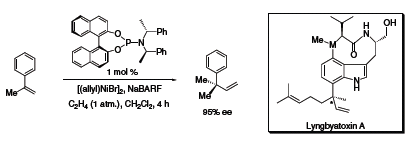
Scheme 9.
Zhang and RajanBabu have also extended this methodology to the asymmetric hydrovinylation of 1,3-dienes. 1,3-dienes were found to be less reactive than the vinylarene derivatives, thus higher temperatures were applied to drive adequate conversions. Under these conditions, the hydrovinylation of conjugated 1,3-diene 7 with the (S,R,R)-phosphoramidite ligand gave exquisite regio- and enantioselectivities (Scheme 10).9
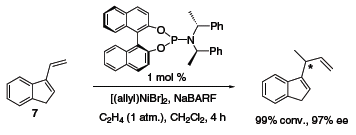
Scheme 10.
Asymmetric Allylic Substitution Reactions
The (R)-MonoPhos™ ligand has been effectively utilized in the enantioselective, iridium-catalyzed allylic substitution reaction.10 Simply mixing an iridium precatalyst and the ligand in THF in the presence of LiCl creates a highly active catalyst, which generates a stereogenic C–C bond center in good to excellent enantioselectivities (Scheme 11). The high product yields and short reaction times further accentuate this methodology for application to the expeditious construction of chiral building blocks.

Scheme 11.
Conclusion
A powerful family of monodentate phosphine ligands has been developed on the well known BINOL backbone, which demonstrates both higher activities and higher enantioselectivities in asymmetric transformations when compared to the majority of bidentate chiral phosphines. These phosphoramidite ligands are accessible in a concise, linear fashion and display robust stability when combined with rhodium precatalysts. We have a range of phosphoramidite ligands available that differ in the amine functionality of the ligand architecture, allowing for rapid optimization of catalyst performance.
Materials
References
To continue reading please sign in or create an account.
Don't Have An Account?